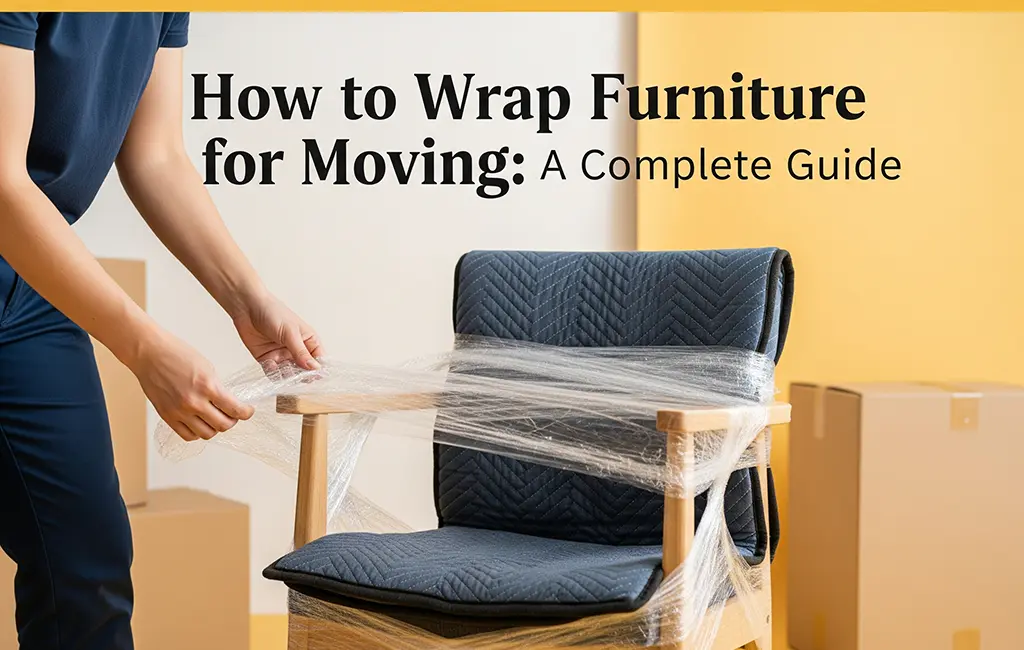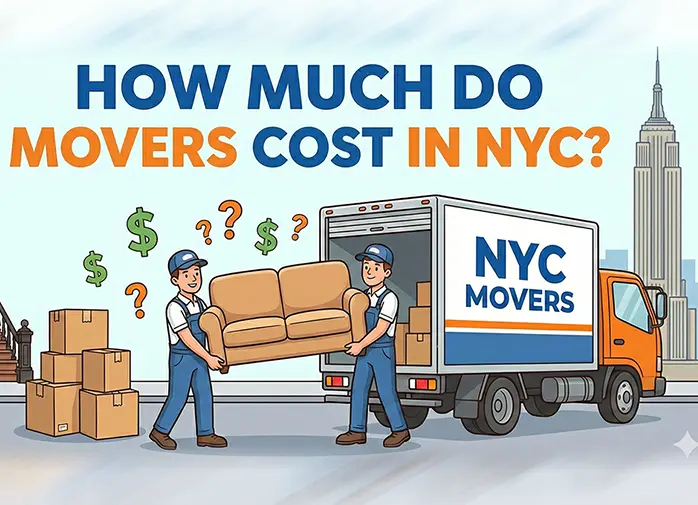How to Wrap Furniture for Moving – Step-by-Step Guide

When preparing for a move, one of the biggest concerns is keeping your furniture safe from scratches, dents, and damage. Properly wrapping furniture not only protects it during transport but also makes the moving process more organized. Whether you’re hiring professional movers or handling the move yourself, learning how to wrap furniture the right way can save you money and stress.
This how to wrap furniture for moving guide walks you through the best materials, methods, and step-by-step instructions for wrapping furniture before a move.
Why Wrapping Furniture Is Important?
- Prevents scratches and dents: Sharp corners, walls, and doorframes can damage unprotected furniture.
- Protects against dirt and moisture: Wrapping keeps dust, spills, and weather conditions from ruining your belongings.
- Makes handling easier: Proper wrapping keeps drawers and doors shut, reducing accidents.
- Keeps furniture valuable: Protecting your investment means your furniture lasts longer after the move.
Materials You’ll Need
Before you start wrapping, gather these supplies:
- Furniture blankets / moving pads – for heavy or large items like sofas, tables, and dressers.
- Plastic stretch wrap – for securing padding and protecting against dust and moisture.
- Packing tape – heavy-duty tape to keep wraps in place (never apply directly on wood or fabric).
- Bubble wrap – for fragile furniture parts or glass surfaces.
- Cardboard sheets – for added protection on flat surfaces.
- Mattress bags – for beds and cushions.
- Scissors or utility knife – for cutting wrap and tape.
Step-by-Step Guide: How to Wrap Furniture for Moving
1. Disassemble When Possible
Take apart large furniture pieces such as beds, dining tables, and bookshelves. Remove legs, drawers, shelves, and cushions. This makes wrapping easier and prevents breakage. Keep screws and hardware in labeled bags so you don’t lose them.
2. Clean and Dry Furniture
Wipe down surfaces before wrapping. Dust and moisture trapped under plastic wrap can cause stains, mold, or scratches during the move.
3. Wrap Delicate Surfaces First
For glass tabletops, mirrors, or polished wood:
- Cover with bubble wrap.
- Add a layer of cardboard for reinforcement.
- Secure with tape (only on the wrap, not the surface).
4. Use Moving Blankets for Large Items
- Drape moving blankets over sofas, dressers, and tables.
- Make sure all corners and edges are covered.
- Use stretch wrap or tape to hold the blanket in place without leaving sticky residue on the furniture.
5. Secure Drawers and Doors
For dressers, cabinets, or desks:
- Empty them first.
- Use stretch wrap to keep drawers and doors from sliding open.
- Avoid taping directly onto wood or painted finishes.
6. Wrap Upholstered Furniture
Couches, chairs, and mattresses can attract dust and odors during a move. Use plastic stretch wrap or furniture covers designed for upholstery to keep them clean. For extra protection, add moving blankets underneath the plastic.
7. Protect Corners and Edges
Furniture corners are most vulnerable to dents. Add cardboard or foam protectors before wrapping to cushion impacts.
8. Label Each Piece
Use masking tape and a marker to label wrapped items (e.g., “Living Room Sofa” or “Dining Table Legs”). This makes unpacking easier and ensures movers know how to handle fragile items.
Pro Tips for Wrapping Furniture
1. Don’t Overuse Tape
One of the most common wrapping errors is applying packing tape directly to furniture surfaces. Not only does this risk peeling paint or finish, but sticky residue can also be nearly impossible to clean off certain materials like wood or leather. Instead, always apply tape only to the wrapping material (such as moving blankets or stretch wrap). Use just enough tape to secure the protective layers—too much can make unpacking frustrating and may even cause accidental cuts or scratches when removed.
2. Double Wrap Fragile Items
Fragile or high-value pieces like glass tabletops, mirrors, antiques, or lacquered wood deserve extra attention. A single layer of blanket or plastic won’t cut it if the truck hits a bump or if boxes shift during transit. Start by covering delicate items in bubble wrap, then add a layer of moving blanket for cushioning, and finally secure everything with stretch wrap. This triple-layer method not only protects against impact but also guards against moisture and dirt.
3. Keep Essentials Accessible
During a move, it’s easy to misplace small but critical items like screws, bolts, or Allen keys used for disassembled furniture. Many people make the mistake of wrapping these parts inside furniture or scattering them in random boxes. Instead, place all hardware in clearly labeled zip-lock bags and tape the bag securely to the furniture piece it belongs to—or keep them together in a dedicated “essentials” box. That way, when it’s time to reassemble, you won’t waste hours searching.
4. Work Room by Room
Tackling the entire house at once can quickly become overwhelming and disorganized. A smarter strategy is to wrap furniture one room at a time. This not only keeps items grouped together for easier unpacking, but also ensures you don’t miss smaller pieces like side tables, stools, or lamps. Label each wrapped item by room (“Bedroom – Nightstand,” “Living Room – Coffee Table”) so movers know where it belongs and you won’t have to reshuffle furniture once you arrive.
Common Mistakes to Avoid
Skipping Padding on Sharp Edges
Sharp corners on tables, dressers, or bed frames are especially prone to causing damage—not only to the furniture itself but also to walls, doorframes, and other items during the move. Always use corner protectors, foam, or folded cardboard before wrapping the rest of the piece.
Wrapping Dirty or Damp Furniture
Never wrap furniture that hasn’t been cleaned and dried properly. Trapping dust, moisture, or crumbs under plastic wrap can lead to permanent stains, bad odors, or even mold growth during transit. A quick wipe-down and ensuring all surfaces are completely dry will prevent unpleasant surprises when you unwrap.
Using Thin Plastic Bags Instead of Moving-Grade Wrap
Household garbage bags or supermarket plastic wrap are not designed for moving. They tear easily, offer little protection, and may even trap condensation. Always invest in professional moving stretch wrap, which is thicker, stronger, and clingier, ensuring a snug fit without tape directly on your furniture.
Not Labeling Wrapped Items
A wrapped couch may be obvious, but smaller wrapped pieces like chairs, shelves, or headboards can easily be mistaken for each other. Without labels, movers won’t know which room items belong to, and you’ll spend more time sorting after unloading. A simple label like “Bedroom – Dresser” saves hours of confusion.
Forgetting to Protect Furniture Legs and Corners
Legs and corners bear the brunt of movement during a move—they bump into walls, floors, and other furniture. Neglecting to pad and wrap them often results in dents, chips, or broken edges. Use bubble wrap, cardboard corner protectors, or even thick towels to shield these vulnerable areas before applying blankets and plastic wrap.
Conclusion
Wrapping furniture for moving takes time, but the effort pays off in preventing damage and making your move smoother. By using the right materials, following proper wrapping techniques, and avoiding common mistakes, you can protect your furniture and reduce moving-day stress.
If you’d rather skip the hassle, Van Lines Move offers professional furniture moving service to keep your furniture safe from start to finish.
Frequently Asked Questions
1. Should I wrap furniture in plastic or blankets?
Both are useful. Use blankets for cushioning and plastic wrap for sealing and protection from dirt/moisture.
2. How do I wrap a couch for moving?
Remove cushions, cover with a moving blanket, then secure with stretch wrap. For long-distance moves, add a plastic cover for extra protection.
3. Can I use cling film or regular household plastic wrap?
No, household plastic is too thin. Invest in heavy-duty moving stretch wrap for proper protection.
4. How do I protect wood furniture?
Use moving blankets first, then wrap with stretch film. Never put tape directly on wood surfaces.
5. Is bubble wrap necessary?
Yes—for fragile surfaces like glass tabletops, mirrors, or delicate wood finishes. For sturdier items, blankets and stretch wrap are enough.
Categories
- Long Distance Moving153
- Local Moving119
- Commercial Moving40
- Residential Moving34
- Last – Minute Moving25
- Moving Tips & Lifestyle10
- Furniture Moving9
- Moving Tips & How-To Guides8
- Moving services6
- Moving Cost5
- Moving Cost Calculator5
- state to state movers4
- Piano Moving3
- Car Transportation3
- Truck Rental3
- moving tips3
- Local Move3
- Moving companies3
- best moving rates3
- cheap moving companies3
- affordable moving companies3
- full-service movers3
- Moving Cost Guides3
- Junk Removal2
- Moving Container2
- Senior Moving2
- Senior Relocation Moving Companies2
- Moving Tools2
- Moving Estimates2
- interstate moving2
- Moving2
- cross-country move2
- Household moving2
- Moving Costs & Budgeting2
- Moving Tips & State Guides2
- Heavy Equipment1
- Senior Moving Services1
- office moving1
- office relocation1
- employee relocation1
- Car Transport1
- Vehicle Shipping1
- Car Shipping Services1
- Artificial Intelligence1
- Office Moving Services1
- Commercial Moving Companies1
- Corporate Moving Services1
- Corporate Movers1
- full-service moving companies1
- sustainable moving companies1
- green movers1
- Moving in US1
- Best places to move in 20251
- 2025 moving1
- Full-Service Moving Companies1
- College Moving1
- College moving services1
- Moving to College1
- Dorm Moving1
- Tips for moving1
- donate1
- sell1
- Movers in California1
- Movers in Studio City1
- Moving to California1
- Laws about Moving into California1
- Moving Laws1
- House moving1
- packing1
- cheap moving ways1
- Moving guide1
- International moving1
- moving across countries1
- international relocation program1
- move out cleaning1
- right packing supplies1
- pack while moving1
- Apartment moving1
- PODS1
- moving out1
- state to state move1
- California movers1
- Truck Rental1
- US Territory Relocation1
- International Moving1
- Shipping & Moving Tips1
- Moving Tips1
- Relocation Guide1
- Moving Budget Guide1
- Relocation Guides & Incentives1
- Moving Tools & Equipment Guides1
- Moving Services & Options1
- Moving Tips & How-To Guides1
- Moving Day & Settling In1
- Mobile Home Moving1
- Moving Guide & Tips1
- Moving Tips & State Comparisons1
- Moving Tips & City Guides1
- Moving Tips & Cost Guides1
- Long-Distance Moving Tips1
- Moving Tips & Financial Planning1
- Moving Tips & Home Preparation1
- Moving Tips & Planning1
- Vehicle Shipping & Auto Transport1
- Marketing & Lead Generation1
- International Moving Guides1
- San Francisco Moving Guide1
- NYC Moving1
- Local Movers1
- Budget Moving1

 Local Movers
Local Movers Last-Minute Movers
Last-Minute Movers Junk Removal
Junk Removal Long Distance Movers
Long Distance Movers Piano Movers
Piano Movers Heavy Equipment
Heavy Equipment Commercial Movers
Commercial Movers Moving Container
Moving Container Car Transportation
Car Transportation Furniture Movers
Furniture Movers Truck Rental
Truck Rental Moving Cost Calculator
Moving Cost Calculator Moving Planner
Moving Planner Packing Calculator
Packing Calculator Moving Checklist
Moving Checklist Moving Insurance
Moving Insurance FAQ
FAQ Contact Us
Contact Us Moving Loan
Moving Loan About Us
About Us











